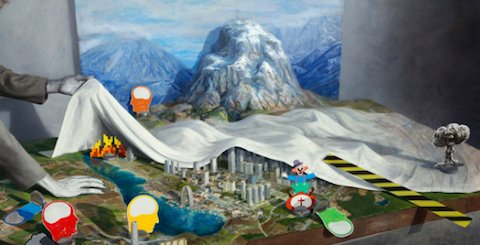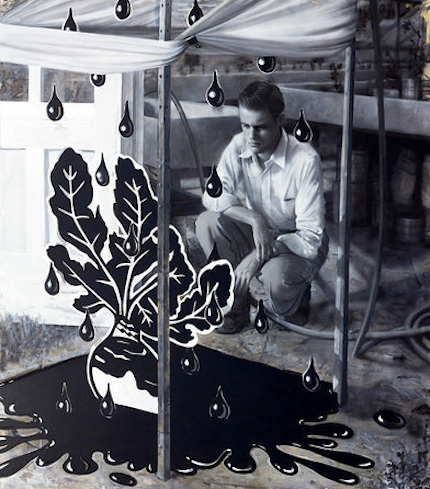
In the Land of Double Letters
Artists’ Housing and Studios in Scandinavia
Roslyn Bernstein
24/01/2012
This story first appeared in Guernica Mag Daily www.guernicamag.com
In contrast to the American ideal of the live-work artist loft, artists in Scandinavia tend to live and work separately. Studios are generally small and rarely in or adjacent to the artists’ homes.
Married Finnish sculptors Riikka and Ville Makikoskela are an exception. They live in The Oulunkyla Studio House, a 16-residence apartment/studio complex built in 1976. An early collaboration of the Artists’ Association of Finland (AAF) and the City of Helsinki, it is ten minutes from the city center by train. Their unit contains a small salon/dining room, two small bedrooms and a modest studio with north light and a high ceiling. The studio is used primarily by Riikka because Ville’s work demands even bigger space. He now rents a 60 square meter (645 sq ft) studio nearby.
Built as an experiment in live/work housing, their Oulunkyla unit worked best for the couple when their children were small. “Now,” said Riikka, “it would be nice to have a more separate studio since toxic smells waft through the house.”
Still, they do not intend to leave because the space is cheap and their tenure is permanent. When they moved there in 2005, thirty-one other artists applied. “You only have to leave when you die,” Riikka, said.
“In the beginning,” Tuula Paalimaki, Director of the Finnish Artists’ Studio Foundation, which administers the housing, explained, “artists got the spaces for five years. Then, it was lengthened to 10 years. Then, if your professional career continued, you got another 10 years.” The result, of course, was that no one ever moves.

Marcus Martenson. Famous Signs and Symptoms of Stress
The association’s office is housed in The Vallila Studio Centre, an industrial property that they renovated into 120 work-only studios in 2008. The association is now designing its first new housing project for artists where residences and studios are to be built in adjacent buildings. With the intent of developing the east side of Helsinki, the deal involves renting land from the City, with building costs divided in thirds: the Finnish government, the City of Helsinki, and the Finnish Artists’ Studio Foundation. With 14 apartments and 14 studios scheduled to open in May 2013, the association has yet to decide who gets to live there.
Although the spaces vary in size, the majority will be one bedroom units, meant for single artists. “This is an experiment,” Paalimaki said, “a social experiment.”
Petru Havu, Director of the AAF, provided a deeper understanding of the artist’s plight in Finland: too many artists, too few studios and too few galleries. At the heart of the problem, according to Havu, “is too much artist education.” Each year there are 20-30 graduates of the academies of fine art and over 200 graduates of the hoch schules (similar to Bachelor of Arts degrees). In addition, more than one third of all Finnish students are attracted to creative professions, to media, journalism, dance, crafts and fine arts. All Finnish students receive free tuition. “It’s very unrealistic,” said Havu, “because there is a small art market in Finland.”
Like many other Swedish artists, [Hans] Andersson struggled to find a studio. His current 250 sq. ft studio is in an industrial building that is definitely not gentrified. … “It is illegal to live here, but some people do it,” he said.
Most Helsinki artists agree that the heart of artistic Helsinki is Kaapeli, the Cable Factory, a culture centre that in addition to studios and offices for painters, photographers, architects, designers, graphic designers and film production companies, includes lively performance and exhibition spaces, museums, galleries, theaters, schools, and sports clubs.
Built during the years 1939-1953, the over 500,000 sq. ft factory once housed Nokia, then a cable and phone equipment manufacturer. By the spring of 1989, the building was dark, empty and, said Stuba Nikula, manager director, “scary.” Several brave architects, visual artists and photographers moved in. Today, the Cable factory is financially independent with their revenue exceeding expenses by over one million euros per year, money which they plow back into the building.
There are 250 long-term tenants, including 130 artist studios. “We try to hide the fact that this is a city-owned project because we don’t feel like administration,” Nikula said. Tenants are encouraged to mount exhibits on hallway walls, floors are open from 7 AM to 9 PM every day, and there are toilets and showers.

Katja Tukiainen. Idyll II. From Deer Forest Paintings. 2011
Painter Katja Tukiainen came to the Cable Factory in 2000, after being on the list for five years. “The list is a mystery,” she said. Tukiainen shares her fifth floor studio with her husband Matti Hagelberg, a comic artist, and “plans to stay in the studio forever.”
A new project on the other side of Helsinki, one-quarter the size of the Cable Factory, is already in the works. “There are already 400 potential tenants in the queue for studio and work spaces,” Nikula said.
Long lines for studios are common in Stockholm, Sweden, too, according to Andreas Ribbung, a painter who is one of the founders of the artist-run gallery Candyland and who is the creative force behind The Supermarket, a February alternative art fair. Ribbung shared a basement studio with several other artists before he and his artist brother Mattias Larson moved to the store, currently occupied by Candyland. Recently, he’s taken a studio in an old factory just outside the city center where seven artists have taken over two floors.
Hans Andersson, who now shows with the Angelika Knapper Gallery in Stockholm, knows the artist-run scene well having exhibited in artist-run shows in Iceland, Finland, Berlin, and New York. Andersson works with found materials: his recent show at Knapper included works on pages from an old Chinese photo album. Like many other Swedish artists, Andersson struggled to find a studio. His current 250 sq. ft studio is in an industrial building that is definitely not gentrified. It is a “lumpy, shabby environment” that he described as one “conducive to making art.” He shares a floor with seven other artists but lives elsewhere. “It is illegal to live here, but some people do it,” he said.

Kristoffer Zetterstrand. The Wild Plant. 2011
Kristoffer Zetterstrand, a painter who uses computers to design his paintings, has had three solo exhibits at the Peter Bergman Gallery in Stockholm since 2002. Zetterstrand’s basement studio, formerly a carpenter shop, suits much of his recent work. His unique work process involves starting a painting, scanning it into a computer, and adding elements on the screen. Once he finalizes the image, he prints it out and then paints the canvas.
It is a mixture of traditional painting bound with new media, a technique that he thinks he invented. Zetterstrand would like to make larger work but the size of the door to his studio limits him. “I solved the problem by making diptychs,” he said.
Competition for studio space and galleries is no easier in Copenhagen where the norm is to have working space outside of one’s home. Sculptor Mette Ussing is unique, living in a landmarked building that was designed for artists, overlooking Copenhagen’s Botanical Garden. After a 22-year wait, she finally moved into her large live/work space.

Kristoffer Zetterstrand. pwned Landscape. 2010
Anja Franke’s studio is in her house in Herlev, a suburb of Copenhagen, where she is exploring the limits of public space. She has turned her front yard into an exhibition space for visiting artists, uses a small room for her studio and does installations in the large rear yard. Several years back, Franke built an igloo in Los Angeles artist Jenna Didier’s front garden. “As an artist, our home and daily life are our background material for doing art. It is not just a traditional thing but a choice. I am not so commercial,” said Franke who was curator of the alternative art fair, alt_cph11: Encounters held at Copenhagen’s Factory of Art and Design in September.
Whatever their living and studio situation, the goal of most of the artists is to have their work shown. They would do good to heed the words of Stockholm gallery owner Magnus Karlsson, who will be exhibiting at the May 4-7 Frieze Art Fair on Randall’s Island. “I tell them don’t be so picky. Just show. It’s better to be shown than to rot in some basement.”
Roslyn Bernstein is an arts journalist and a professor of journalism at Baruch College and the CUNY Graduate School of Journalism. She is the author of Boardwalk Stories and the co-author, with Shael Shapiro, of Illegal Living: 80 Wooster Street and the Evolution of SoHo.
She has reported from the United States, Eastern Europe, Israel and China for publications including The New York Times, Newsday, The Village Voice, New York, Parents, Contemporanea, American Banker, Artnews and the Columbia Journalism Review.